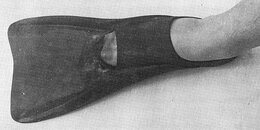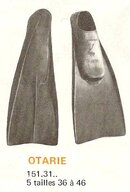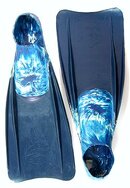I have a pair of these from '62 and they are in nice shape. You've got yourself quite a find. Those fins were worn by some very famous and heroic individuals throughout history. I would posit that the only fin that is more historically famous is the Cressi Rondine.
You are using an out of date browser. It may not display this or other websites correctly.
You should upgrade or use an alternative browser.
You should upgrade or use an alternative browser.
Duck feet
- Thread starter DaleC
- Start date
Please register or login
Welcome to ScubaBoard, the world's largest scuba diving community. Registration is not required to read the forums, but we encourage you to join. Joining has its benefits and enables you to participate in the discussions.
Benefits of registering include
- Ability to post and comment on topics and discussions.
- A Free photo gallery to share your dive photos with the world.
- You can make this box go away
David Wilson
Contributor
Thanks all for your replies.
David, does that mean these things are from 1955 or older? That would seem incredible as the rubber is in very good to excellent shape, supple with no cracking at all.
I guess it does, Dale, and the fins' longevity is a tribute to the purity of the material, unadulterated by "fillers" that might have shortened their useful lives. I don't think I have any equipment dating so far back, but I do have a "new old stock" drysuit from the late 1950s which is still serviceable, so material quality, careful use and good maintenance are key factors.
I agree with the others that you now own a bit of history. The Spearfisherman Company dates are mentioned here, by the way:
VDTdecalPage2
I was looking for other sources to corroborate, but the ones I found a few years ago seem to have suffered "link-rot" and vanished.
I would posit that the only fin that is more historically famous is the Cressi Rondine.
Indeed. Here's an image of the prototype, which I've read somewhere was originally made from car tyre rubber:

More information about Luigi Ferraro, who designed the Rondine, here:
Rondine Fins | Luigi Ferraro
More information about Luigi Ferraro, who designed the Rondine, here:
Rondine Fins | Luigi Ferraro
I think it's a bit funny that when I read stories about Ferraro, it suddenly sets in on me that the ships he was sabotaging under penalty of death were the allies in World War II. He was one bad motor-scooter.
DaleC
Contributor
here's a couple more fins and masks I saw. Is anything "interesting" historically?
Aqualung. One foot pocket is ripped but could be repaired.


French?


Mid 70's era? The purge valve is rotted away.

Snorkeling mask. It doesn't have the indents to facilitate equalization.


Aqualung. One foot pocket is ripped but could be repaired.


French?


Mid 70's era? The purge valve is rotted away.

Snorkeling mask. It doesn't have the indents to facilitate equalization.


Many early scuba masks did not have finger pockets. There was either a pad or in some cases nothing. You pressed up against the bottom to close the nostrils to facilitate clearing the ears. Finger pockets were once something considered in a similar light to purge valves today, why?
If needed you could always lift the mask, use your fingers and then clear mask. Why have those silly pockets, that is what they said, but, the pockets are nice. People expect so much nowadays .
.
AL still makes the Pacifica and the Atlantis masks. Many military and commercial divers like them. N
If needed you could always lift the mask, use your fingers and then clear mask. Why have those silly pockets, that is what they said, but, the pockets are nice. People expect so much nowadays
AL still makes the Pacifica and the Atlantis masks. Many military and commercial divers like them. N
Zieg
Contributor
The Spearfisherman Company is one of the oldest skin diving equipment manufacturers in the world, trading between 1945 and 1955, when the owner Arthur Brown sold the firm to Swimaster, later absorbed by Voit. It was based in Huntington Beach in California. The company made Duck Feet fins and also a range of shorty and full-length drysuits, advertised in the first issue of "Skin Diver". You can see some of their advertisements at
Thank you for bit of history. Explains the trail. I've wondered about the Duck Feet - Swimaster connection. So does anyone have an idea of the age of these fins.
Attachments
These are the full-foot Duckfeet, and were also available in the 1950s. I have not used them, but hear that they were pretty good fins.Thank you for bit of history. Explains the trail. I've wondered about the Duck Feet - Swimaster connection. So does anyone have an idea of the age of these fins.
I have two pairs of Swimaster Duckfeet, and like them a lot. But they don't fit my feet with heavy neoplene booties on, so I only use them in the pool anymore. These were my first fins, and I used them throughout my early diving in the Pacific Northwest. When I went into the US Air Force, and went through the US Naval School for Underwater Swimmers, we had to use the AMF Voit version of these fins. I say "had" because I liked my Swimaster Duck Feet fins better, and wore them upside down. This gave better support on long swims to the arch of the foot. You couldn't do that with the AMF Voit version of the Duck Feet, as when Voit took them over, legend has it Swimaster destroyed the dies and AMF Voit "improved" the fin in the new dies.
Here are some photos I took of my classmates in the US Naval School for Underwater Swimmers, in Key West, Florida in 1967 using their AMF Voit Duckfeet:

Photo by John C. Ratliff

Photo by John C. Ratliff
This photo is out of one of my older books, and shows a US Navy diver (it's an "Official US Navy Photo") near the bow of a submarine:

From: Bergaust, Erik and William Foss, Skin Divers in Action, G.P. Putnam's Sons, New York, 1965, page 64.
The Spearfisherman Co. is listed as the manufacturer of "Duck Feet, true gum rubber, translucent, sm., med., med.-lg., lg." for $8.95. The "Extra large" version sold or $12.95 in 1957. (From Rick & Barbara Carrier, dive, The Complete Book of Skin Diving, 1957 (first edition), 265.
I also have a pair of the US Divers Co...more later--I'm being called for supper!
As I was saying, I have a pair of US Divers Co. Aqualung fins too. I had to use them when in the USAF, and did not like them at all. The ones I got there were very stiff and hard. Well, as a part of another regulator purchase, I also got a pair of Aqualung fins too, and decided to try them in a pool last summer. They actually were very nice fins. These were black ones, and not nearly as stiff as I remembered. They have a great spring to the rubber, and were a very powerful fin. So while initially I did not like them as well as my Duck Feet, now they are about comparable. Unfortunately, I tried them on over a pair a thing boots, and broke the strap on one. This normally would be the death of a fin of this type, but I found that with wet suit cement, and bicycle inner tube, I could repair the strap (wrapping the bicycle inner tube around the fin after gluing it together, and gluing the inner tube around it for support). So I still have them, but because of the strap they are now a pool-only fin.
____________________________
DaleC,
The snorkel on that mask does not work well in current. I tried one a long time ago, and in heavy river current the current tends to bend it around the jaw, and pinch off the opening so that it is very difficult to breath.
SeaRat
Last edited:
David Wilson
Contributor
here's a couple more fins and masks I saw. Is anything "interesting" historically?
Aqualung. One foot pocket is ripped but could be repaired.


It's the US Divers version of the vintage "Otarie" (French for "sea-lion") full-foot fin. When I tried them once, I found the blades incredibly stiff compared to those of modern rubber full-foot fins. US Divers still uses the names "Otarie" and "Sea Lion" for rubber full-foot fins, which are now made in Malaysia and purchasable via Amazon.com.
La Spirotechnique's French version of vintage Otaries is illustrated below:

The above was scanned from a La Spirotechnique catalogue from the late 1960s.
French?


Yes, these fins were manufactured by Beuchat et Cie of Marseilles, the firm which invented "fixe-palmes", triangular fin retainers, and the original Jetfin. These "Espadon" fins resemble the Beuchat "Paralleles" fins below from a Beuchat catalogue of the same period:

The Skooba Totes drysuit clad model below in a Submarine Products catalogue is wearing a pair of similar Beuchat full-foot fins, but without the additional heelstrap:

Historical interest is probably a very subjective concept, but I find the Otarie interesting because it's such as a classic, unembellished, gimmickry-free design. I like the toe openings on these fins because the foot pockets are long enough to accommodate the entire foot, including the toes. A large toe opening isn't necessary, which makes that part less likely to tear at what can be a stress point, and there's less of a flow of cold water through the fins, which makes wearing them barefoot more comfortable.
As for the Beuchat fins, the additional straps are interesting (I see only the buckles remain), although not unique. US Divers, Cressi Sub of Italy and Turnbull of Australia also added this feature to their full-foot fins in the late 1950s and 1960s. One or two models even sported instep straps across the top of the foot as well as the heel strap. Only one modern rubber full-foot fin still comes with a heelstrap, the Free Sub "Jet", made in Turkey:

Also interesting are the closed toes, which were reasonably common in the same era, although open toes were considered to remove the risk of toes sustaining abrasion. Hydrodynamic Champion yellow closed-heel, closed-toe fins were very popular in the 1960s, particularly with female divers:

Now that the Technisub Ala is out of production, the only modern sources of closed-heel, closed-toe rubber fins are Russia and Ukraine:
Alphaplastic Delfin

Kievguma Akvanavt

The Russian-made Delfin (Dolphin) is very soft, while the Ukraine-manufactured Akvanavt (Aquanaut) has quite stiff blades.
Last edited:
Thanks David
I always appreciate the historical knowledge you bring to any fin discussion and I am not normally big into all the different kinds fins©ª just basically use Jetfins most of the time.
I always appreciate the historical knowledge you bring to any fin discussion and I am not normally big into all the different kinds fins©ª just basically use Jetfins most of the time.
David Wilson
Contributor
Thanks David
I always appreciate the historical knowledge you bring to any fin discussion and I am not normally big into all the different kinds fins©ª just basically use Jetfins most of the time.
Thanks Luis. I appreciate the acknowledgement. I'm always happy to add my two cents' worth when vintage diving discussions broach the topics of fins, masks and suits.
As for Duck Feet fins, photographs in early diving manuals suggest that they weren't always easy on the feet if the following image from Bronson-Howard's "Handbook for Skin Divers" (1956) is anything to go by:

The diver in the picture (Hope Root, 52-year-old Miami attorney who met his death attempting a record-breaking dive in the Gulf Stream in 1953) is wearing his fins over thick socks, over some kind of diving bootie. Swimaster appear to have been aware of this characteristic and to have come up with the idea of what they called "flipper slippers" to protect bare feet:

I wonder whether the rightmost diver in your image below, John, might be wearing them? They don't look like ordinary neoprene booties:

Similar threads
Trip Report
Flower Gardens September 12 - 14
- Replies
- 9
- Views
- 575
- Replies
- 7
- Views
- 898
- Replies
- 12
- Views
- 1,838




